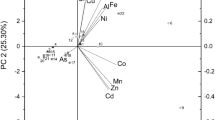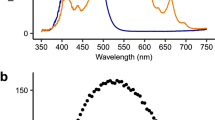Abstract
The effects of 16 different combinations of nutrient load and agitation on yield, nutrient uptake and proximate chemical composition of the seaweed Ulva lactuca cultured in tanks were evaluated. Intensive fishpond outflow passed through seaweed tanks at four nutrient loading levels and four water agitation combinations of water exchange, bottom aeration and frequently changing water levels (an accelerated tide regime). Specific results from these outdoor experiments were examined further under controlled conditions in laboratory experiments. Agitation treatments affected the performance of U. lactuca only under TAN (\({\text{NH}}_{3} + {\text{NH}}^{ + }_{4} \)) load levels below 4 g N m−2 day−1; biofiltration of TAN was the parameter most affected. Biomass yields at each of the four nutrient loading levels were not significantly different between the agitation treatments. Protein content increased significantly with increasing nutrient loading. The agitation treatments had a slight effect on seaweed protein content only at the lowest nutrient loading levels. There were no significant differences in dissolved oxygen concentration, pH, and temperature among the agitation treatments at all nutrient loading levels. Under laboratory conditions, growth rates, protein content, and photosynthetic and biomass yield of the seaweed were affected by water velocity under low nutrient concentrations. It is concluded that the effect of air agitation under the conditions of these experiments was not directly related to photosynthesis, excess dissolved oxygen, or carbon limitation, but to the diffusion of macro nutrients from the water to the seaweed. Therefore, once nutrient concentrations are high enough (above about 4 μM of TAN with the other nutrients in their corresponding proportions), aeration per se is not essential for effective growth and biofiltration by seaweeds.



Similar content being viewed by others
References
Beer S, Ilan M, Eshel A, Weil A, Brickner I (1998) Use of pulse amplitude modulated (PAM) fluorometry for in situ measurements of photosynthesis in two Red Sea faviid corals. Mar Biol 131:607–612
Bidwell RGS, McLachlan J, Lloyd NDH (1985) Tank cultivation of Chondrus crispus Stackh. Bot Mar 28:87–97
Bird K (1989) Intensive seaweed cultivation. Aquac Mag 1989:29–34
Blaedel WJ, Meloche VW (1957) Elementary quantitative analysis: theory and practice. Row, Peterson and Company, New York
Boarder SJ, Shpigel M (2001) Comparative performance of juvenile Haliotis roei fed on enriched Ulva rigida and various artificial diets. J Shellfish Res 20:653–657
Chopin T, Buschmann AH, Halling C, Troell M, Kautsky N, Neori A, Kraemer G, Zertuche-Gonzalez J, Yarish C, Neefus C (2001) Integrating seaweeds into aquaculture systems: a key towards sustainability. J Phycol 37:975–986
Cohen I, Neori A (1991) Ulva lactuca biofilters for marine fishpond effluents. I. Ammonia uptake kinetics and nitrogen content. Bot Mar 34:475–482
Craigie JS, Shacklock PF (1995) Culture of Irish moss. In: Boghen AD (ed) Cold-water aquaculture in Atlantic Canada, 2nd edn. The Canadian Institute for Research on Regional Development, Moncton, pp 241–270
DeBusk TA, Blakeslee M, Ryther JH (1986) Studies on the outdoor cultivation of Ulva lactuca L. Bot Mar 29:381–386
Dodds WK (1991) Community interactions between the filamentous alga Cladophora glomerata (L.) Kutzing, its epiphytes and epiphyte grazers. Oecologia 85:572–580
Doty MS (1971) Measurement of water movement in reference to benthic algal growth. Bot Mar 14:32–35
Duke CS, Lapointe BE, Ramus J (1986) Effects of light on growth, RuBPCase activity and chemical composition of Ulva species (Chlorophyta). J Phycol 22:362–370
Duke CS, Litaker RW, Ramus J (1989) Effects of temperature, nitrogen supply and tissue nitrogen on ammonium uptake rates of the chlorophyte seaweeds Ulva curvata and Codium decorticatum. J Phycol 25:113–120
Evans F, Langdon CJ (2000) Co-culture of dulse Palmaria mollis and red abalone Haliotis rufescens under limited flow conditions. Aquaculture 185:137–158
Friedlander M, Dawes CJ (1985) In situ uptake kinetics of ammonium and phosphate and chemical composition of the red seaweed Gracilaria tikvahiae. J Phycol 21:448–453
Gao K, Aruga Y, Asada K, Ishihara T, Akano T, Kiyohara M (1992) Photorespiration and CO2 fixation in the red alga Porphyra yezoensis Ueda. Jap J Phycol 40:373–377
Glenn EP, Doty MS (1992) Water motion affects the growth rates of Kappaphycus alvarezii and related red seaweeds. Aquaculture 108:233–246
Gonen Y, Kimmel E, Friedlander M (1993) Effect of relative water motion on photosynthetic rate of red alga Gracilaria conferta. Hydrobiologia 260/261:493–498
Hanisak MD, Ryther JH (1984) Cultivation biology of Gracilaria tikvahiae in the United States. Hydrobiologia 116/117:295–298
Huguenin JH (1976) An examination of problems and potentials for future large-scale intensive seaweed culture systems. Aquaculture 9:313–342
Israel A, Friedlander M, Neori A (1995) Biomass yield, photosynthesis and morphological expression of Ulva lactuca. Bot Mar 38:297–302
Krom MD, Grayer S, Davidson A (1985) An automated method of ammonia determination for use in mariculture. Aquaculture 44:153–160
Krom MD, Ellner SP, van Rijn J, Neori A (1995) Nitrogen and phosphorus cycling and transformations in a prototype “non-polluting” integrated mariculture system, Eilat, Israel. Mar Ecol Prog Ser 118:25–36
Lapointe BE, Ryther JH (1978) Some aspects of the growth and yield of Gracilaria tikvahiae in culture. Aquaculture 15:185–193
Lapointe BE, Ryther JH (1979) The effects of nitrogen and seawater flow rate on the growth and biochemical composition of Gracilaria foliifera var. angustissima in mass outdoor cultures. Bot Mar 22:529–538
Lobban CS, Harrison PJ, Duncan MJ (1985) The physiological ecology of seaweeds. Cambridge University Press, Cambridge
Madsen TV, Sand-Jensen K (1991) Photosynthetic carbon assimilation in aquatic macrophytes. Aquat Bot 41:5–40
Madsen JD, Chambers PA, James WF, Koch EW, Westlake D (2001) The interaction between water movement, sediment dynamics and submerged macrophytes. Hydrobiologia 444:71–84
McHugh DJ (2003) A guide to the seaweed industry. FAO Fisheries technical paper no. 441. FAO, Rome
Msuya FE (2004) The influence of culture regimes on the performance of seaweed biofilters in integrated mariculture. PhD Thesis, Tel Aviv University, Tel Aviv, Israel
Neori A (1996) The type of N-supply (ammonia or nitrate) determines the performance of seaweed biofilters integrated with intensive fish culture. Isr J Aquac-Bamidgeh 48:19–27
Neori A, Cohen I, Gordin H (1991) Ulva lactuca biofilters for marine fishpond effluents. II. Growth rate, yield and C:N ratio. Bot Mar 34:483–489
Neori A, Krom MD, Ellner SP, Boyd CE, Popper D, Rabinovitch, Davidson PJ, Dvir O, Zuber D, Ucko M, Angel D, Gordin H (1996) Seaweed biofilters as regulators of water quality in integrated fish-seaweed culture units. Aquaculture 141:183–199
Neori A, Msuya FE, Shauli L, Schuenhoff A, Fidi K, Shpigel M (2003) A novel three-stage seaweed (Ulva lactuca) biofilter design for integrated mariculture. J Appl Phycol 15:543–553
Neori A, Chopin T, Troell M, Buschmann AH, Kraemer GP, Halling C, Shpigel M, Yarish C (2004) Integrated aquaculture: rationale, evolution and state of the art emphasizing seaweed biofiltration in modern mariculture. Aquaculture 231:361–391
Ni IH, Wu M, Shek S, Qian PY (1999) Integrated mariculture. I. Comparison of nutrients uptake among macroalgae, phytoplankton and bacteria. APEC Conference on Sustainability of Marine Environment: What Can the Private Sector Do? Kaohslung, Chinese Taipei, 1–3 September 1999
Parker HS (1981) Influence of relative water motion on the growth, ammonium uptake and carbon and nitrogen composition of Ulva lactuca (Chlorophyta). Mar Biol 63:309–318
Phang SM, Miah MS, Yeoh BG, Hashim MA (2000) Spirulina cultivation in digested sago starch factory wastewater. J Appl Phycol 12:395–400
Rosenberg G, Ramus J (1982) Ecological growth strategies in the seaweeds Gracilaria foliifera (Rhodophyceae) and Ulva sp. (Chlorophyceae): soluble nitrogen and reserve carbohydrate. Mar Biol 66:251–259
Shpigel M, Ragg NL, Lupatsch I, Neori A (1999) Protein content determines the nutritional value of the seaweed Ulva lactuca L for the abalone Haliotis tuberculata L. and H. discus hannai Ino. J Shellfish Res 18:227–233
Smith FA, Walker NA (1980) Photosynthesis by aquatic plants: effects of unstirred layers in relation to assimilation of CO2 and \({\text{HCO}}^{ - }_{3} \) and to carbon isotopic discrimination. New Phytol 86:245–259
Troell M, Robertson-Andersson D, Anderson RJ, Bolton JJ, Maneveldt G, Halling C, Probyn T (2006) Abalone farming in South Africa: an overview with perspectives on kelp resources, abalone feed, potential for on-farm seaweed production and socio-economic importance. Aquaculture 257:266–281
Vandermeulen H (1989) A low-maintenance tank for mass culture of seaweeds. Aquac Eng 8:67–71
Vandermeulen H, Gordin H (1990) Ammonia uptake using Ulva (Chlorophyta) in intensive fishpond system: mass culture and treatment of effluent. J Appl Phycol 2:363–374
Vergara JJ, Sebastián M, Pérez-Lloréns JL, Hernández I (1998) Photoacclimation of Ulva rigida and U. rotundata (Chlorophyta) arranged in canopies. Mar Ecol Prog Ser 165:283–292
Wallentinus I (1984) Comparisons of nutrient uptake rates for Baltic macroalgae with different thallus morphologies. Mar Biol 80:215–225
Acknowledgements
F.M. expresses her gratitude for the support provided by a World Wildlife Fund scholarship and by Tel Aviv University, George S. Wise Faculty of Life Sciences, Department of Botany. The Israeli National Centre for Mariculture (NCM) funded part of the research. The Institute of Marine Sciences of the University of Dar es Salaam is thanked for granting the time for F.M.’s study. Special thanks to S. Beer for his continual support and guidance. We also acknowledge the technical help of V. Odintsev, L. Shauli, A. Zalmanzon, and the Departments of Nutrition, Engineering, and Maintenance at NCM. Finally, we thank M. Friedlander, A. Schuenhoff, G. Kissil, and two anonymous reviewers for their many useful comments.
Author information
Authors and Affiliations
Corresponding author
Rights and permissions
About this article
Cite this article
Msuya, F.E., Neori, A. Effect of water aeration and nutrient load level on biomass yield, N uptake and protein content of the seaweed Ulva lactuca cultured in seawater tanks. J Appl Phycol 20, 1021–1031 (2008). https://doi.org/10.1007/s10811-007-9300-6
Received:
Revised:
Accepted:
Published:
Issue Date:
DOI: https://doi.org/10.1007/s10811-007-9300-6




